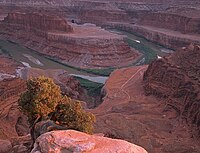Portal:Utah/Selected article/18

The Colorado River is a river in the southwestern United States and northwestern Mexico, approximately 1,450 mi (2,330 km) long, draining a part of the arid regions on the western slope of the Rocky Mountains. The natural course of the river flows into the Gulf of California, but the heavy use of the river as an irrigation source for the Imperial Valley has desiccated the lower course of the river in Mexico such that it no longer consistently reaches the sea.
The Colorado River's headwaters are located in Rocky Mountain National Park, just west of the Continental Divide. Once inside Utah, the river turns south partially forming the southern border of Arches National Park near Moab, Utah, then passes by Dead Horse Point State Park and through Canyonlands National Park where it is met by one of its primary tributaries the Green River. The river then flows into Lake Powell, formed by the Glen Canyon Dam and into Arizona.
The Colorado River is a major and in some cases life-sustaining source of water for irrigation, drinking, and other uses by people living in the arid American southwest. Allocation of the river's water is governed by the Colorado River Compact. Several dams have been built along the Colorado River, beginning with Glen Canyon Dam near the Utah-Arizona border. Other dams include Hoover Dam, Parker Dam, Davis Dam, Palo Verde Diversion Dam, and Imperial Dam. Since the completion of the dams, the majority of the river in normal hydrologic years is diverted for agricultural and municipal water supply. The Colorado's last drops evaporate in the Sonoran Desert, miles before the river reaches the Gulf of California. Almost 90% of all water diverted from the river is for irrigation purposes. The All-American Canal is the largest irrigation canal in the world and carries a volume of water from 15,000 to 30,000 ft³/s (420 to 850 m³/s), making it larger in volume than New York's Hudson River. The canal's waters are used to irrigate the parched but fertile Imperial Valley, where several years can pass between measurable rainfalls.
